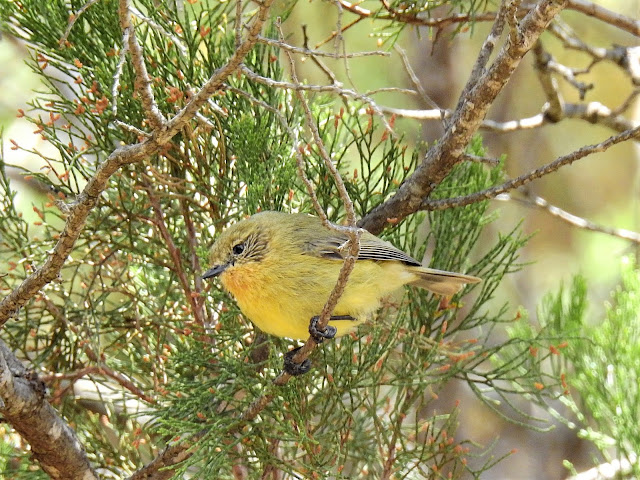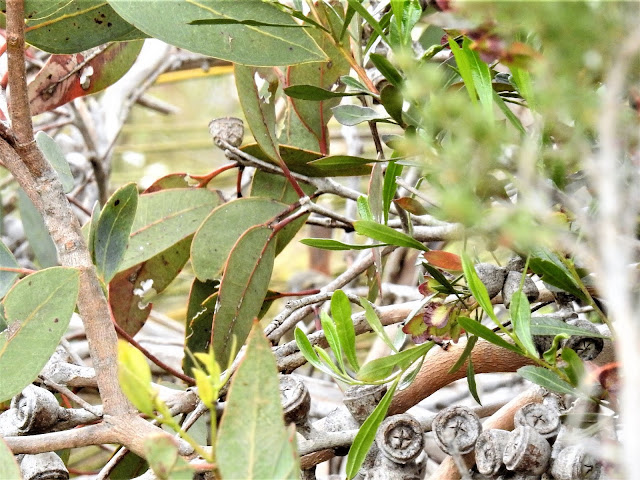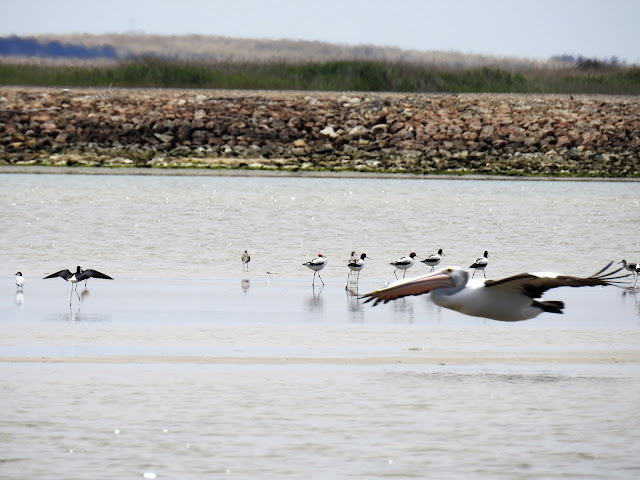We passed through Monarto on our way to Mt Barker. Many birders had been visiting Browns Road Monarto with great results. The area had a spot to stop for lunch. I spent just 1 hr wandering about the immediate area.
Yellow Thornbills.
Yellow-rumped Thornbills forage on the ground.
Southern Whiteface
Grey Currawong.
We stayed at Mt Barker for several nights.
I visited Laratinga Wetlands. The wetlands was constructed in 1999 by Mount Barker Council for the disposal of treated water from the Wastewater Treatment Plant that is on the boundary fence of the wetland. The large artificial wetland was created to further filter the water & reuse it for local irrigators, parks & gardens.
There are a series of different wetland ecosystems with walkways over the water & tracks leading around all of the ponds. The total area is just 17 ha with 11 ha under water.
I visited the wetland on 2 occasions, 1 afternoon to get my bearings of the myriad of tracks.
On my 1st visit I saw 35 bird species in the 100 minutes I was there.
Superb Fairywrens were in plenty of places.
Hoary-headed Grebe
Male Hardhead duck.
Common Bronzewing.
I spied on 3 Aust Spotted Crakes foraging along the channel of water between 2 of the larger lakes.
Also in that area were Black-fronted Dotterels.
This is a Mallard & Pacific Black Duck hybrid.
Australian Reed Warbler
I returned 2 days later after dropping hubby off for a golf game. I could spend longer wandering around the wetland. I saw 51 bird species on that visit.
Another Aust Reed Warbler in a different area.
Pacific Black Duck baby learning to feed at such a young age.
Also in similar area to the Freckled Duck were Australasian Shovelers.
On this outing I saw 6 Australian Spotted Crakes. The sun was starting to come out from the clouds.
Another Superb Fairywren looking for insects along the path.
50 Pink-eared ducks were further back behind the fence & in the actual Wastewater Treatment Plant Ponds. Birders can view these sets of ponds through the fence with great views of the ducks.
Female Hardhead
Hoary-headed Grebe's again
Also there were several Blue-billed Ducks.
Dusky Moorhen
Water rat, a surprise entry onto the path in front of me.
Musk Lorikeets were in the near by Eucalypts.
Welcome Swallow parents were kept busy with this group of 4 recently fledged chicks.
Crested Shrike-tit was also seen in the bushes near ponds.
We drove further south into the Fleurieu Peninsula to stop at a little caravan park outside Mt Compass. If we had more time & not towing a caravan I would have stopped at several places along the journey as we drove through the very pretty Mount Lofty ranges.
I visited Mount Compass Wetland & Boardwalk.
The Fleurieu Swamps have been protected by Australian Govt legislation so that they remain forever as they are & not under any further threat from land clearing & farming.
The boardwalk is just 730m in length & I was surrounded by mostly thick bushes.
As I walked quietly along the boardwalk I heard the unmistakable calls of a Lewins Rail.
With lots of waiting patiently I managed to see 2 birds in a tiny open space amongst the thick growth.
I heard the Southern Emu-wren during the walk, but it stayed close to cover.
I also saw European Goldfinchs.
Whilst we stayed at Mount Compass, we took a days drive to the coastline around Port Noarlunga to Aldinga Beach. We passed McLaren Vale vineyards.
I spent 2.5 hours walking around Onkaparinga River Recreational Reserve. There were 47 bird species that morning as I walked a 4 km trail.
Immature Australasian Grebe
More Spotted Crakes were foraging along the shallow parts of the wetland.
A Cattle Egret had called this wetland home for some time.
Pacific Black Duck & bub.
Australasian Shoveler.
This specie has had a name change - Black winged Stit is now Pied Stilt.
Golden-headed Cisticola
Another family of Pacific Black Ducks.
We moved further south to stay at Normanville.
Common Blackbird on the bushes near the caravan park we stayed at.
Rainbow Lorikeet ssp eyrei
I got a better opportunity to photograph an adult Crimson Rosella ssp fleuriensis in the caravan park.
Red Wattlebirds were quite common birds to hear & see through much of Fleurieu Peninsula.
I couldn't work out what the purpose of this concrete wall was off the coast of Normanville, however it is a resting spot for plenty of ocean feeding birds including Cormorants.
Along the beach were a few waders including Red-necked Stint.
Red-capped Plovers were also there.
Nankeen Kestrel hovers looking for it's next meal.
Eastern Spinebill
We hopped on the vehicle ferry to Kangaroo Island to spend 8 days there. I have dedicated a separate chapter to Kangaroo Island.
After disembarking the vehicle ferry from Kangaroo Island we spent a night in Deep Creek Conservation Park. The heathland walking trail in the CP was amazing if you love flora too.
Beautiful Firetail
Crescent Honeyeater.
Eastern Spinebill were feeding young still in a nest.
Bassian Thrush
We moved camp to stay at Goolwa for 4 nights. I visited Cox's Scrub. This heathland was another amazing place to visit. I walked a mere 600 m during my 4 hrs visit & saw 37 bird species. It doesn't seem much for 600m, but that's the quality of this heathland with flowering native bushes everywhere. I also saw 10 Elegant Parrots along that walk.
It's been along time since I've seen perched Brush Bronzewings.
There's a bird in the centre on this photo.....can you see the Chestnut-rumped Heathwren? The bird just didn't want to show itself fully & kept hiding behind the bushes.
Grey Currawong.
A group of Beautiful Firetails were coming down to a small puddle of water along the track.
After lunch I visited Goolwa Wastewater Treatment Plant & wetland for a couple of hours.
Pink-eared Duck
A family of Black Swans & their 5 cygnets.
More muddy margins in a wetland & another Aust Spotted Crake.
Mid afternoon we took a drive to the Goolwa Barrage that joins Coorong National Park. The Barrage is the wall that holds Lake Alexandrina fresh waters back from flowing out into the Southern Ocean.
Whiskered Terns were there.
In the middle is a Kelp Gull.
The next day we went on a 6 hr Coorong NP boat trip. The cruise is a tourist trip & not a birding trip, so I had to make do with how close I saw the birds that day.
The Coorong NP side of the barrage were thousands of waders stretched for approximately 35 kms of our cruise.
Far Eastern Curlew
Red-necked Avocets
Black-winged Stilts / Pied Stilts on the right.
Red-necked Avocets.
There were thousands of Teal along the Coorong.
Grey Plover in the centre of the photo The other waders are Sharp-tailed Sandpipers.
Fairy Tern in the centre.
Many of the waders were in the distance on the edges of the water course.
Curlew Sandpipers.
A large flock of Red-necked Avocets.
Black-tailed Native-hens.
Royal Spoonbills
Mostly Teal ducks in the photo below. I also heard a Spotted Crake at Cattle Point. Along the cruise I also saw Pied & Sooty Oystercatchers, 50 Cape Barren Geese, Aust Shelducks, Bar-tailed Godwits, Common Greenshanks & quite possibly many other un identified waders.
We drove around the circumference of Lake Alexandrina. We stopped at Tolderol Game reserve with the idea of camping there for the night, but the mosquitoes & other flying insects were horrendous. Hubby un hitched the caravan for me to spend 5 hours exploring the huge reserve by car. There were about a dozen ponds of water to drive around, plus areas of muddy paddocks.
All up I found 48 bird species there. I was rather surprised there weren't that many species of ducks there though, with just a few Pacific Black Ducks, Grey Teal & Aust Shelducks = 30 ducks in total.
Golden-headed Cisticola.
White-fronted Chats in the samphire.
There were possibly 500 Whiskered Terns feeding for insects over the ponds.
A young Whistling Kite with a feed of fish.
Swamp Harrier.
Red-kneed Dotterel
Aust Spotted Crake. I also heard 2 Spotless Crakes in the thick reeds on 1 pond next to a track.
Amongst the 200 or so Sharp-tailed Sandpiper 1 bird stood out.
It's a Pectoral Sandpiper.
After unhitching our caravan at Meningie's Lake Albert caravan park we drove to Noonameena along the Coorong NP. I could see plenty of waders in the distance through my spotting scope, but they were too far to ID.
Australasian Pipit.
On our way towards Salt Creek we stopped at a couple more sites for me to check what waders use the Coorong NP.
Common Greenshank were at Parnka Point.
White-fronted Chats were there too.
We unhitched at Salt Creek caravan park behind the service station. We may have had some difficulty in finding a camp spot in the National Park camp sites due to low overhanging trees & tight corners.
We drove into the Coorong NP along Loop Road & I walked a couple of areas. I've not seen Emu walk across a body of water before, especially salt water.
Not far down Loop Road was an active Malleefowl mound. I should have returned later in the afternoon for a few hours in wait for him to come back. Instead I hatched a plan to return in the morning thinking this would be more likely time to see the bird. It was a bad move as after sitting on the provided viewing area seat at 7am for 30 mins, light rain started, that turned into a heavy downpour. I returned to my car saturated & no Malleefowl sighting.
Red-rumped Parrots were checking on a nesting box in the Salt Creek community.
Banded Stilts were in 1 of the lakes on my way out the next morning after the down pour.
I saw Long-billed Corellas at Millicent.
We were in Port MacDonnell for me to go on a Pelagic trip (ocean bird watching trip) in 2 days time.
I birded along the coast near Port MacDonnell to see several waders including Ruddy Turnstone, Curlew Sandpipers, Sanderlings, Pacific Golden Plovers, Red Knot amongst others.
Eurpean Greenfinch near Port MacDonnell.
Whilst in Port MacDonnell I visited Pick Swamp. There were a couple of Brolga on the expansive dry grasses.
This bird is the reason I was at Pick Swamp. Several Australasian Bitterns call this wetland home. With some luck 2 birds flew up from the swampy grasses & flew in opposite directions.
Bool Lagoon & Hacks Lagoon are 25 kms south of Naracoorte, or about 100kms north of Mt Gambier. We camped right next to the waters edge of Hacks Lagoon which is on the other side of the road to Bool Lagoon.
Bool Lagoon & Hacks Lagoon are freshwater lagoon systems, are a seasonal wetland that is home to a wide range of wildlife & provides essential drought refuge foe many rare & endangered bird species. In 1985 both lagoons were placed on the list of wetlands of International Importance maintained by the Ramsar Convention. I walked & drove between the 2 wetlands for an entire afternoon & several hours the next morning. It was birding heaven.
Birds seen but not photographed include Magpie Geese, Black Swans, 200 Grey Teal, 80 Shovelers, 200 Pink-eared Ducks, 80 Hardheads, both Ibis sp, 250 Coots, 2 Grebe's sp, Swamp Harrier, a Lathams Snipe, a Lewin's Rail, 50 Black-tailed Native-hens, a Southern emu-wren & several other species.
This is just 1 area of the very expansive Bool Lagoon
This male Musk Duck was just metres from the waters edge, the closest I've yet to see 1 of these species.
Also in that same pond of water was a male Blue-billed Duck.
I hopped in our car & stopped at several spots along the 3 km long road. An area where the water was more shallow I saw a Buff-banded Rail ever so briefly as it moved about the muddy sections.
A Brown Falcon landed on a tree along the road.
During the afternoon I could hear Australasian Bitterns calling periodically from both lagoons.
As I walked along 1 section of the road in the late afternoon my eyes gazed into the tall
grasses < 6 m from the road.
Wow, wow, wow.....how good is that, an Australasian Bittern standing in it's typical posture so close to me. I could hear several of these birds calling during the night, 1 not that far from our caravan.
I spent several hours birding along the roadway the next morning.
This is part of the 500 m boardwalk through part of Bool Lagoon.
Sacred Kingfisher
For some reason I never got decent photos of European Goldfinch.
My last SA state tick was Rufous Songlark along the road near Bordertown.
We exited the state further north near Pinnaroo & drove across to Hattah. I wanted another try at locating Mallee Emu-wren. I visited 2 areas without success....again :-(
Australian Ringneck at 1 of the locations in Hattah-kulkyne NP.
I looked up at the right time to see a Little Eagle cruising overhead.
I drove into Nowingi Track at Hattah-kulkyne NP to spend a couple of hours wandering around areas where the Mallee Emu-wren had been reported by various people on many previous occasions.
Sadly I didn't see them , but there was a potential peak from the spinifex, but I eventually had to leave empty handed. I was so very disappointed.
White-browed Babbler
Varied Sittella
A Painted Dragon was out warming up in the early morning light.
After leaving our brief visit into Victoria, we entered NSW. We called into Yarrie Lake near Narrabri for me to do some more birding. The lake is quite full. Campers can camp around the edge of the lake, powered sites are $25 or $20 for no power.
I found my target bird amongst the casaurina forest at the back of the lake.
Painted Honeyeater.
White-breasted Woodswallows were also there.
That finished my birding trip of South Australia. I have 2 more chapters to complete.....Kangaroo island & Pelagic Trip off Port MacDonnell each have their own chapter.
The birding through out my 3 month SA has been wonderful with very diverse habitats to cover.































































































































No comments:
Post a Comment